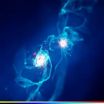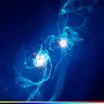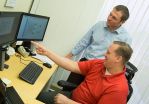(Press-News.org) VIDEO:
In about five billion years time, nearby massive galaxy Andromeda will merge with our own galaxy, the Milky Way, in an act of galactic cannibalism (technically Andromeda will be eating...
Click here for more information.
Massive galaxies in the Universe have stopped making their own stars and are instead snacking on nearby galaxies, according to research by Australian scientists.
Astronomers looked at more than 22,000 galaxies and found that while smaller galaxies are very efficient at creating stars from gas, the most massive galaxies are much less efficient at star formation, producing hardly any new stars themselves, and instead grow by eating other galaxies.
Dr Aaron Robotham, who is based at the University of Western Australia node of the International Centre for Radio Astronomy Research (ICRAR), said smaller 'dwarf' galaxies were being eaten by their larger counterparts.
"All galaxies start off small and grow by collecting gas and quite efficiently turning it into stars," he said.
"Then every now and then they get completely cannibalised by some much larger galaxy."
The study was released today in the journal Monthly Notices of the Royal Astronomical Society, which is published by Oxford University Press.
Dr Robotham, who led the research, said our own Milky Way is at a tipping point and is expected to now grow mainly by eating smaller galaxies, rather than by collecting gas.
"The Milky Way hasn't merged with another large galaxy for a long time but you can still see remnants of all the old galaxies we've cannibalised," he said.
"We're also going to eat two nearby dwarf galaxies, the Large and Small Magellanic Clouds, in about four billion years."
But Dr Robotham said the Milky Way is eventually going to get its comeuppance when it merges with the nearby Andromeda Galaxy in about five billion years.
"Technically, Andromeda will eat us because it's the more massive one," he said.
Almost all of the data for the research was collected with the Anglo-Australian Telescope in New South Wales as part of the Galaxy And Mass Assembly (GAMA) survey, which is led by Professor Simon Driver at ICRAR.
The GAMA survey involves more than 90 scientists and took seven years to complete.
This study is one of over 60 publications to have come from the work, with another 180 currently in progress.
Dr Robotham said as galaxies grow they have more gravity and can therefore more easily pull in their neighbours.
He said the reason star formation slows down in really massive galaxies is thought to be because of extreme feedback events in a very bright region at the centre of a galaxy known as an active galactic nucleus.
"The topic is much debated, but a popular mechanism is where the active galactic nucleus basically cooks the gas and prevents it from cooling down to form stars," Dr Robotham said.
Ultimately, gravity is expected to cause all the galaxies in bound groups and clusters to merge into a few super-giant galaxies, although we will have to wait many billions of years before that happens.
"If you waited a really, really, really long time that would eventually happen but by really long I mean many times the age of the Universe so far," Dr Robotham said.
INFORMATION:
Further Information:
ICRAR is a joint venture between Curtin University and The University of Western Australia with support and funding from the State Government of Western Australia.
Original publication details:
'Galaxy and Mass Assembly (GAMA): Galaxy close-pairs, mergers and the future fate of stellar mass' in the Monthly Notices of the Royal Astronomical Society.
Published online 19/9/2014 at: http://mnras.oxfordjournals.org/lookup/doi/10.1093/mnras/stu1604
Preprint version accessible at: http://arxiv.org/abs/1408.1476
Images:
Images and video are available at: http://www.icrar.org/mergers
Contacts:
Dr Aaron Robotham
ICRAR – UWA (Currently travelling in South Africa, GMT +2:00)
E: aaron.robotham@icrar.org
Professor Simon Driver
Principal Investigator of the GAMA project. ICRAR – UWA (Perth, GMT +8:00)
Ph: +61 8 6488 7747 M: +61 400 713 514 E: simon.driver@icrar.org
Kirsten Gottschalk
Media Contact, ICRAR (Perth, GMT +8:00)
Ph: +61 8 6488 7771 M: +61 438 361 876 E: kirsten.gottschalk@icrar.org
UWA Media Office
Ph: +61 8 6488 7977
Monster galaxies gain weight by eating smaller neighbors
2014-09-19
ELSE PRESS RELEASES FROM THIS DATE:
The 'Angelina Effect' was not only immediate, but also long-lasting
2014-09-19
Referrals for genetic counselling and testing for breast cancer risk more than doubled across the UK after actress Angelina Jolie announced in May last year that she tested positive for a BRCA1 gene mutation and underwent a double mastectomy. The rise in referrals continued through to October long after the announcement was made. This is according to research published in the journal Breast Cancer Research.
New research based on data from 21 centers shows that many more women approached their GPs with concerns. Far from these being women with unfounded concerns, it ...
Experts issue plea for better research and education for advanced breast cancer
2014-09-19
Breast cancer experts around the world have issued a plea to researchers, academics, drug companies, funders and advocates to carry out high quality research and clinical trials for advanced breast cancer, a disease which is almost always fatal and for which there are many unanswered questions.
In the latest international consensus guidelines for the management of advanced breast cancer, published simultaneously in the leading cancer journals The Breast and Annals of Oncology [1] today (Friday), the experts say that further research and clinical trials are "urgently needed" ...
Gun deaths twice as high among African-Americans as white citizens in US
2014-09-19
The researchers looked at all recorded gun deaths across the USA between 2000 and 2010, to include murders, suicides, and unintentional shooting, using data from the Injury Statistics Query and Reporting System.
Hawaii recorded the lowest rate of gun deaths at 3.02 per 100 000 citizens, while the District of Columbia topped the league table at 21.71 per 100 000. Rates rose in Florida and Massachusetts, largely owing to more gun deaths among people of white and non-Hispanic ethnicities, and an increase in the gun related murder rate.
Firearm deaths fell in Arizona, California, ...
Cooling of dialysis fluids protects against brain damage
2014-09-19
Washington, DC (September 18, 2014) — While dialysis can cause blood pressure changes that damage the brain, cooling dialysis fluids can protect against such effects. The findings come from a study appearing in an upcoming issue of the Journal of the American Society of Nephrology (JASN). The cooling intervention can be delivered without additional cost and is simple to perform.
While dialysis is an essential treatment for many patients with kidney disease, it can cause damage to multiple organs, including the brain and heart, due to the sudden removal of bodily fluids. ...
Vitamin E, selenium supplements unlikely to effect age-related cataracts in men
2014-09-18
Taking daily supplements of selenium and/or vitamin E appears to have no significant effect on the development of age-related cataracts in men, writes Author William G. Christen, Sc.D., of Brigham & Women's Hospital and Harvard Medical School, Boston, and colleagues.
Some research, including animal studies, has suggested that dietary nutrients can have an effect on the onset and progression of cataracts. Vitamin E and selenium are of particular interest.
The authors report the findings for cataracts from the Selenium and Vitamin E Cancer Prevention Trial (SELECT) Eye ...
Exercise boosts tumor-fighting ability of chemotherapy, Penn team finds
2014-09-18
Study after study has proven it true: exercise is good for you. But new research from University of Pennsylvania scientists suggests that exercise may have an added benefit for cancer patients undergoing chemotherapy.
Their work, performed in a mouse model of melanoma, found that combining exercise with chemotherapy shrunk tumors more than chemotherapy alone.
Joseph Libonati, an associate professor in the School of Nursing and director of the Laboratory of Innovative and Translational Nursing Research, was the senior author on the study, which appears in the American ...
Researchers study vital 'on/off switches' that control when bacteria turn deadly
2014-09-18
MADISON, Wis. — No matter how many times it's demonstrated, it's still hard to envision bacteria as social, communicating creatures.
But by using a signaling system called "quorum sensing," these single-celled organisms radically alter their behavior to suit their population. In short, some bacteria "know" how many of them are present, and act accordingly.
Once the population of quorum-sensing bacteria reaches the millions, it may change from innocuous to pathogenic, or from unhelpful to helpful. The quorum-sensing messages are carried in small molecules that the bacteria ...
Researchers develop unique waste cleanup for rural areas
2014-09-18
PULLMAN, Wash. - Washington State University researchers have developed a unique method to use microbes buried in pond sediment to power waste cleanup in rural areas.
The first microbe-powered, self-sustaining wastewater treatment system could lead to an inexpensive and quick way to clean up waste from large farming operations and rural sewage treatment plants while reducing pollution.
Professor Haluk Beyenal and graduate student Timothy Ewing in the Voiland College of Engineering and Architecture discuss the system in the online edition of Journal of Power Sources ...
Video games could dramatically streamline educational research
2014-09-18
PULLMAN, Wash. – "Seeking educational curriculum researchers. Humans need not apply."
A Washington State University professor has figured out a dramatically easier and more cost-effective way to do research on science curriculum in the classroom – and it could include playing video games.
Called "computational modeling," it involves a computer "learning" student behavior and then "thinking" as students would. Rich Lamb, who teaches science education at WSU's College of Education, said the process could revolutionize the way educational research is done.
Lamb's research ...
Tree rings and arroyos
2014-09-18
Boulder, Colo., USA – A new GSA Bulletin study uses tree rings to document arroyo evolution along the lower Rio Puerco and Chaco Wash in northern New Mexico, USA. By determining burial dates in tree rings from salt cedar and willow, investigators were able to precisely date arroyo sedimentary beds 30 cm thick or greater. They then combined this data with aerial imagery, LiDAR, longitudinal profiles, and repeat surveys to reconstruct the history of these arroyos.
Arroyos are deep, oversized channels that have vertical or steeply cut walls made up of silt, clay, or sand. ...




